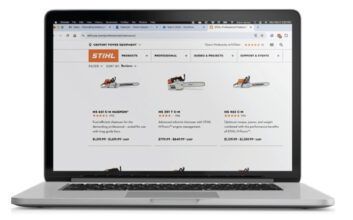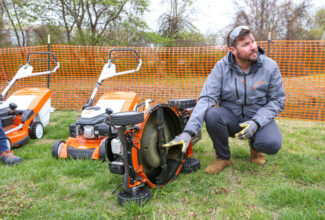Kill Your Clipboards – Digital Transformation Time
“All of this technology is happening across our lives, but not in dealerships,” said Sean McLaughlin, CEO of Flyntlok and owner of Craig Taylor Equipment, an OPE dealer group in Alaska. “On a scale of 1 to 10, with 10 being the highest level of technology implementation, power-equipment dealers are at about 2.”
Along with selling and servicing John Deere and Bobcat equipment, McLaughlin is in the software business. He started Flyntlok to be the cloud-based dealer-management system (DMS) he wanted for his OPE dealerships. “So much transformation needs to happen. That’s why I’m spending my time in this space. And even the things we do take it to about a 4.”
“If a dealer doesn’t currently have a DMS, I don’t know how they can survive the next few years,” said Tim Berman, innovation manager for Ideal Computer Systems. “Thousands of dealers are not running shop-management software at all, or maybe they’re using Peachtree (now called Sage 50) accounting software.”
“In OPE, we still see small family-owned businesses that have operated the same way for years, and many are not operating digitally,” said Ronnie Coulam, senior digital sales manager for Dealer Spike.
You expect people who work for software companies to say that power-equipment dealers need new and better software. But technology has benefits well beyond just boosting the profits of software companies. Retail experts across markets need to look more closely at digital opportunities around them – especially in uncertain market conditions.
An article in Harvard Business Review about a year ago advised business owners to do three things in a slowing business climate. “Accelerate digital transformation” was one of those three things. “The benefits of a well-thought-out digital strategy are well documented: improved visibility of resources and better resource management, enhanced flexibility and organization agility, lower costs, smoother supply chain management, better customer experience,” and more, wrote Vijay Govindarajan, professor at Dartmouth College’s Tuck School of Business.
“It is not the time to slow digital transformation,” he continued. “It’s the time to accelerate it. The volatile environment is throwing up more challenges that can best be addressed by digital transformation, as well as opportunities that facilitate digital transformation.” He points to traditional retail companies and says that digital transformation can help retailers “identify shopping patterns, understand buying behaviors, adjust promotions and special offers, personalize product recommendations, tweak pricing on the fly, and balance supply with fast-changing demand and customer preferences.”
If a clipboard and pencil, or whiteboard and marker, are important tools in the operation of your dealership, you should keep reading. Digital technologies can improve the efficiency and profitability of your service shop, your sales team, and your overall business operation. Here’s how.
Business Operations Transformed
“When I talk about digitization of the space,” said McLaughlin, “we’re designing a system that mines data. The first step is getting the digital exhaust. McLaughlin defines “digital exhaust” (the term was new to me too) as all the data that follows a person’s online shopping activity. “All the clicks are meaningful, especially when you apply machine learning to it. But OPE dealers are not optimized to use that digital exhaust.”
At McLaughlin’s dealerships, he says he has “about 100 business entities in our system” – that’s customers who have purchased from him. “We know what every customer has purchased before, and we can use that to predict what they will need next. We can rank probabilities on that; their digital exhaust improves our system’s predictive learning.”
McLaughlin’s Flyntlok software incorporates an “item genome” feature. “The genome gets data from us and all the manufacturers, with specs and applications and photos – all the info we can acquire. This information used to come from manufacturers on ‘price tapes’ and some dealers still call it that. This is the fundamental digitization of data.” The software will ingest that data from a manufacturer, McLaughlin explains, “and every time a customer or dealer interacts with a particular part from that manufacturer, that all becomes digital exhaust. And then when a new work order is created, parts recommendations will happen.” A rough equivalent is the recommendation you might get from Amazon when you shop.
While Flyntlok is making this possible, not every wholegoods manufacturer has an ordering system that makes this possible. McLaughlin says that Stihl, John Deere, and Kubota are among the OEMs that have digitally connected ordering systems.

Such systems, when integrated with a well-designed DMS, can help OPE dealers improve the value of every interaction they have with a customer. “The most fun we have,” said McLaughlin, “is trying to predict what the customers actually want, and machine learning helps us do this.” He says they are always looking for ways to digitize information and use machine learning to improve customer service. When the digital transformations happen, salespeople can be trained less and solve problems faster to improve customer interactions throughout your dealership.
“You know you’re succeeding if the phone rings less,” said McLaughlin. “This is happening in many other industries. When you get your car serviced, the communication is automated so you have no questions or problems. You can even pay by text.”
Service Profitability Transformed
Technology is transforming service shops so dealers stay efficient and profitable, without relying on service staff to recall every piece of information. “Automated pricing is a big one,” said Tim Berman. “Use your DMS to automatically charge more for parts in service use as opposed to retail sales, this can be automated. It’s generally not happening. Some dealers want to, but they don’t know how to.”
Let your systems automate different functions of the service and billing process. “Dealers can automate things like recycling fees, battery excise taxes, shop supplies, and more,” said Berman. “Pricing for parts margins by dealer’s cost can all be setup in the system. Set up low-price items to have higher margins, then margins drop as retail price rises. Automate this or you’re going to forget one or two and you’ll be losing money. This saves you time on training new staff and creating process checklists. Get this work off the whiteboard and the clipboard and into your DMS. Pricing doesn’t sound super sexy, but this is a set-it-forget-it way to make more money. You don’t have to hire someone else to do this.”
McLaughlin is using technology to improve service performance too. “Many older and experienced service techs are savants who can diagnose and fix anything, but we have fewer of them today,” he said. “We can get there with machine learning. We’re already doing this in service, using data and coding with AI too. When we get digitization right, this will benefit all our customers.”
Marketing Transformed
“It all starts with a good website,” said Paul Berkholtz, senior territory manager for Dealer Spike, “but some dealers still use just Facebook as their digital presence. Meanwhile, their customers and potential customers are looking online and shopping online, and these dealers need to be more visible.”
“Many power-equipment dealers have the common enemy of the big-box stores,” said Tony Zane, sales manager for Dealer Spike, “that all have a very active digital presence. And it’s mobile. That’s why a lot of initial sales go to the big-box stores.

“A lot of dealers have created great customer relationships and have built a business they believe is based on word-of-mouth marketing,” said Coulam. “But WOM is as much online, maybe more so today. We pick up our cell phones whenever we have questions, and we look at reviews from pizza to power equipment. And if dealers doubt this, we ask how many people walked into their store. Then we can show dealers how many people looked at their website. We have analytics right on a website dashboard.”
A website builder like Dealer Spike has a range of pricing packages. “We tailor it to the dealer’s goals,” said Zane. “If they want to do more ecommerce, more marketing, or if they just want to start with the basics.” The key, he says, is to start with a software company that has connections to industry manufacturers and suppliers. Software looks like Squarespace and Wix can make website building a DIY opportunity. But those sites will not have the connectedness of a site built by a company with industry connections.
“From a marketing perspective, the opportunities are the same across many industries,” said Brett Morris, owner of Dealers Digital, “and it’s about data.” Morris has developed websites and digital strategies for a range of OPE dealers. His main digital strategy for dealers aligns with McLaughlin’s “digital exhaust” reference. “It’s about how dealers collect and use data about customers and their shopping habits,” said Morris.
Transformed Customer Communication
Dealers need to make it a priority to get customer contact info, especially email addresses. “Capture email addresses at point of sale,” said Morris. “Asking for an email address to register a warranty makes it part of the sales process,” he said, “without scaring the customer into thinking they will get a bunch of marketing messages.”
Send those customers messages that are helpful to them first, messages that add value to the products they purchased at your store. “It needs to be topical and relevant,” said Morris, “ZTR maintenance specials should not go to the person who bought a subcompact tractor.”
Look for a solution that works with a CRM (customer relationship manager), Morris and Dealers Digital have one. “Segment your customer lists,” he said, “that’s important, and I like email for that.”
Dealers need to take control of their own data. “With margins seemingly shrinking on wholegoods sales,” said Morris, “wouldn’t it be easier to reach out to the customers and market to the people who have already purchased a mower, to sell them parts, service, warranty, etc. Dealers need to be mining that data. Who bought when? What are the service and purchase cycles? Ultimately, it’s up to the dealer.”
You should automate much of this communication, according to Ideal’s Tim Berman. Especially for service. “About 30 percent of our dealers are doing two-way text communication, and many are automating this for service.”
Ideal is rolling out an automated communication service that notifies a customer when service work is being done. “No dealer can have someone on the phone calling all service customers to update them on work,” he said.
This transformation can help on the sales side too. “One of our dealers was growing fast and struggled to keep in touch with customers for satisfaction checks. This is possible,” said Morris, “a lot of software can survey customers. And you can automate Google reviews.” Morris said this dealer just wanted to see the feedback for internal uses. “But he said it’s got to be automated because I don’t have time to make the calls.”
Technology is not a magic wand for all the work in their stores. Or as McLaughlin put it, “Yes, dealers still need to do the daily $&*t, shower, shave, and then we can all do the cool technology work using all the digital exhaust.”





